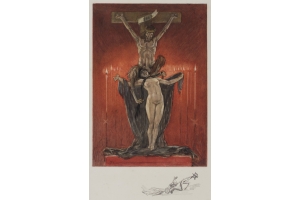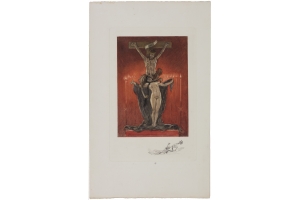

"Sales representative of indecencies on behalf of the firm Satan & Co".....the capacity with which Rops introduced himself to Joséphin Péladan.
"Le Calvaire" leaves little space for speculations and is a bold and brutal parody on the crucifixion of Jesus Christ....Christ replaced by the devil "BELZ" for Belzebub, Lord of the Demons/The Devil/Satan with satyr legs strangulating a mesmerized naked woman who seems to welcome her destiny while taking the same posture as Christ.
Born in a wealthy family, Félicien Rops got interested in Art already at young age, sketching and drawing in the blank margins of music scores while his father played Beethoven and Mozart. He abandoned his studies in Law and Philosophy and his artistic career begins with Rops' society-criticising satirical illustrations for "Uylenspiegel, journal des ébats artistiques et littéraires (1853-1863)".
In 1857 he marries Charlotte Polet de Faveaux, who inherits chateau Thozée, where Félicien hosts most of his artistic friends. Through the editor Auguste Poulet-Malassis Rops is introduced to the famous etcher Félix Bracquemond and Charles Baudelaire, the latter who brings a radical change into his career. Together with his friend Armand Rassenfosse Félicien develops the Ropsenfosse technique (a most refined version of the vernis mou technique) .
Rops had a love-hate affair with Paris where he would become one of the best-paid and most famous illustrators (Les Epaves, Les Diaboliques). He boasted to be even better paid than Gustave Doré. Every year he felt the urge to visit the artistic capital for some three months, after which he needed to recover from the sultry climate of the metropole. It is here in Paris, where he meets the sisters Léontine and Aurélie Duluc, who became his maîtresses. The meandering rest to recover from Paris, Rops finds during travels to Swiss, Belgium, Scandinavia, Hungary, Spain, Holland, USA, Africa, Bretagne and Monaco where he recovers from the gloominess. It is here in the countryside, where Rops unwinds and draws his serene pure subjects, which form a welcome contrast to the feverish Parisian crucible.
Finally, Rops found his comfort in the countryside of Corbeil, where he bought the "Demi-Lune", close to the river Seine. He died in 1898 surrounded by Léontine, Aurélie, his daughter Claire and his close friends Rassenfosse and Detouche.